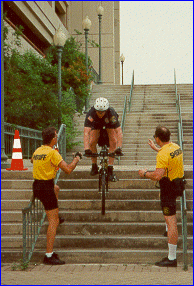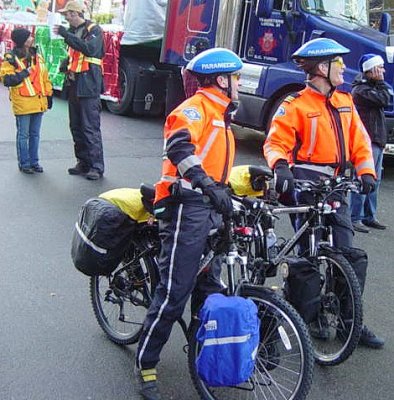 A bicycling manual for police officers in the UK might be getting a lot of laughs over there, but bike-police training is a serious business in the US.
A bicycling manual for police officers in the UK might be getting a lot of laughs over there, but bike-police training is a serious business in the US.
The Independent reports that a 93-page, 2-volume manual gives advice on how to balance to avoid a fall, and how to brake, turn and avoid the “kerb.” It reminds them to eat and drink because they will get hungry.
A taxpayers' association called it an “absurd waste of police time” and tax money. London's bike-riding Mayor Boris Johnson even took a couple of pot shots at it.
That reaction might surprise US members of the International Police Mountain Bicycle Association, which is holding its 8-day annual conference in St. Louis from May 1-8, 2010.
Skills
Since 1991, the association has trained 20,000 police officers and EMS technicians in bike-handling skills. The association maintains that law enforcement from a bike saddle requires special skills than normal recreational bike riding.
For instance, the basic police cyclist 4-day training course puts students in the saddle for 20 hours to learn the following skills:
Bike Handling & Vehicular Cycling, Bike Fit, Group Riding, Hazard Recognition & Common Crashes, Obstacle Clearing & Riding Techniques, Patrol Procedures, Nighttime Patrol, Community Policing, Basic Maintenance, Legal Issues & Traffic Laws, and Fitness & Nutrition.
EMS
In addition, the emergency medical service training session lasts five days. The instruction includes:
“.. basic and emergency bike-handling skills, riding single and in pairs under various traffic conditions, ways to effectively and safely pack equipment, techniques designed to safely handle EMS scenes, and personal safety techniques.”
In 2008, the St. Paul and Minneapolis police departments got special bike response team training in crowd control before the 2008 Republican National Convention.
Manual
The IPMBA also publishes a training manual, costing $31. 95, that's recommended for bike police and bike-mounted EMTs. The Complete Guide to Public Safety Cycling covers:
” … bicycle types and components, clothing and personal protective equipment, skill development, hazard avoidance, bike maintenance, nutrition and fitness, funding, and bike safety education for children.”
Other topics include police-specific equipment, patrol procedures and tactics, firearms training, and campus and security operations.
 Special skills
Special skills
I wonder if the IPMBA guide is much different than the lambasted training manual in the UK.
Bicycle-based police work has been common in US cities for more than two decades. It's credited with putting police in closer contact with the public. EMS workers on bikes can get into congested events much quicker on a bike.
The IPMBA says that most police officers and EMS technicians probably already know how to ride a bike as recreation. Riding in heavy traffic, pursuing suspects over curbs or on stairs and avoiding oncoming cars requires special training, however.
Maybe the UK manual needed to stress the bike-handing skills that are more unique to law enforcement.
Picture at top from website of International Police Mountain Bike Association; shown above are two EMS workers at a Vancouver, Canada, parade.

Recent Comments